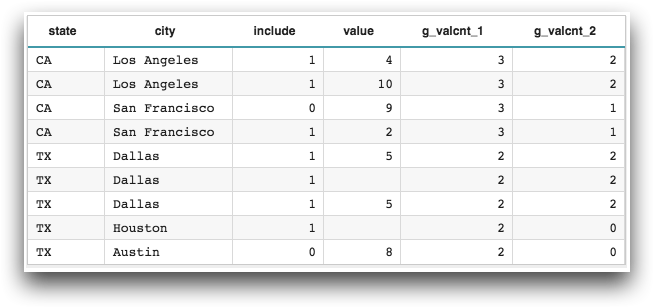g_valcnt(G;S;X)
Returns the number of valid (non-N/A) values within a given group.
Function type
Vector only
Syntax
g_valcnt(G;S;X)Input
| Argument | Type | Description |
|---|---|---|
G |
any | A space- or comma-separated list of column names Rows are in the same group
if their values for all of the columns listed in If If any of the columns listed in |
S |
integer | The name of a column in which every row evaluates to a 1 or 0, which determines
whether or not that row is selected to be included in the calculation If
If any of the values in
|
X |
any simple type | A column name |
Return Value
For every row in each group defined by G (and for those rows where
S=1, if specified), g_valcnt
returns the integer value corresponding to the number of valid (non N/A) values in the
column listed in X that are in the same group as that row.
If all values for a particular group are N/A, the result is 0.
Sample Usage
<base table="pub.doc.samples.ref.func.g_func_sample_usage"/> <willbe name="g_valcnt_1" value="g_valcnt(state;include;value)"/> <willbe name="g_valcnt_2" value="g_valcnt(state city;include;value)"/>

Text N/A Values
For g_functions, there is effectively no text N/A value since the empty string
('') is considered a valid value. Because of this,
g_valcnt(G;S;X) and g_nacnt(G;S;X) may not return the
expected results when dealing with text values. Therefore, you should test explicitly for
empty strings when using this function.
Consider the following table:

The last four columns in the table were created using:
<willbe name="valcnt" value="g_valcnt(department;;item_description)"/>
<willbe name="nacnt" value="g_nacnt(department;;item_description)"/>
<willbe name="isvalid" value="department_description<>''"/>
<willbe name="valcnt_correct" value="g_cnt(department;isvalid)"/>You can see that in the Department Description
(department_description) column, there is only one valid value in
department 22 (SNACKS). However, the g_valcnt(department;;item_description)
function in the valcnt column returns 4, and the
g_nacnt(department;;item_description) function in the
nacnt column returns 0. To find the number of valid values, you can
create a computed column isvalid with the value
department_description<>''. You can then create a computed column
valcnt_correct with the value
g_cnt(department;isvalid) to determine the correct number of valid values
for each department. In the case of department 22, valcnt_correct
displays the correct number of valid values (1).
Example
Let's say we want to know, out of all the entries in the Monthly Statewide Non-Seasonally Adjusted Unemployment Statistics table (pub.fin.fred2.bls.smsu), how many valid values are in the Unemployed column for every state.
<base table="pub.fin.fred2.bls.smsu"/>Create a computed column using the g_valcnt(G;S;X) function. Specify
state as the group (G), since we're grouping by state;
specify unemp as X since we want the valid number of
values in that column; and leave the selection parameter (S) blank, since
we want to take into account all of the entries in the table (not just a subset of those
entries):
<willbe name="validentries" value="g_valcnt(state;;unemp)" label="# of Valid`Unemployment`Values"/>Since we didn't specify a selection column, the validentries column will
show the number of valid unemployment entries for every state. For example, Arkansas
(AK) has 455 valid entries, but Indiana
(IA) only has 395. You can see there are missing values in
the unemp column for Indiana from 01/08 through 12/12.
Now let's see if we can find out how many how many valid values over 150,000 in the
Unemployed column for every state. We essentially want to find out the same
information, but for a subset of our data. For this, we can use the selection column
parameter of the g_valcnt(G;S;X) function.
Create a computed column that evaluates to true if the Unemployed value is greater than 150,000:
<willbe name="over_150" value="unemp>150000" label="Over`150,000"/>Now, use the over_150 computed column as the selection column in the
g_valcnt(G;S;X) function:
<willbe name="validentries_over_150" value="g_valcnt(state;over_150;unemp)" label="# of Valid`Unemployed`Over 150,000"/>The validentries_over_150 column shows the total number of non N/A values
over 150,000 in the Unemployed column for every state.
